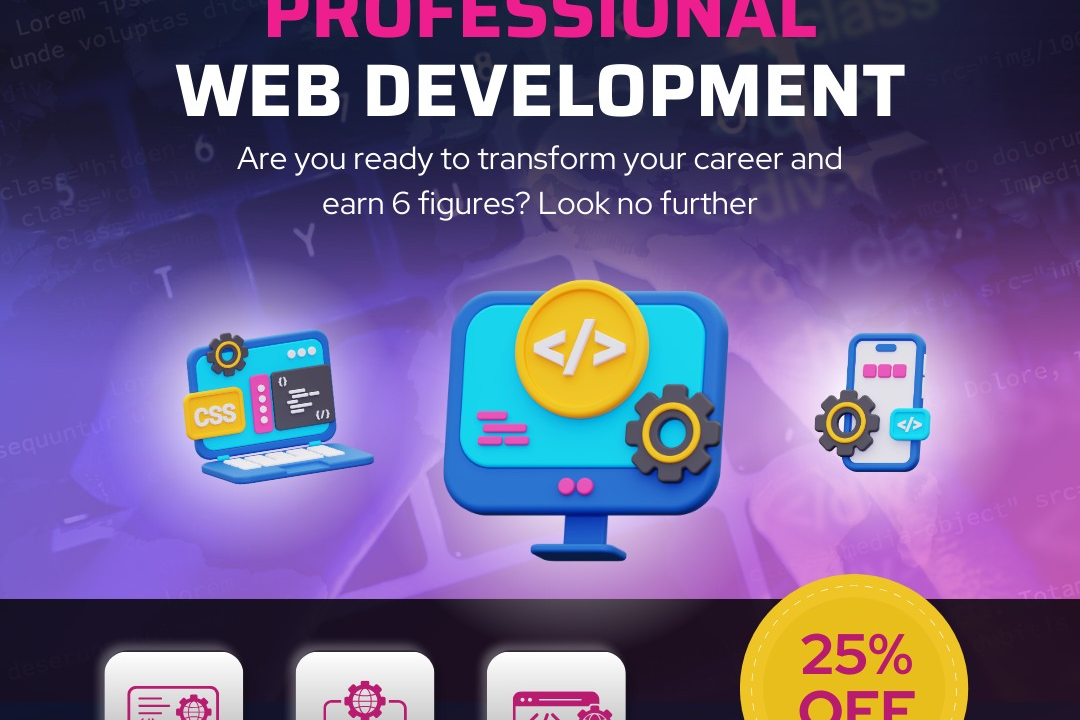How Run A Php Program
Running a PHP program involves writing PHP code in a file with a .php extension and executing it on
How Run A Php Program
Running a PHP program allows developers to create dynamic and interactive websites by generating content on the fly based on user input or data. PHP is widely used because it seamlessly integrates with HTML and database systems like MySQL, making it ideal for building feature-rich web applications such as e-commerce sites, blogs, and portals. Its server-side execution ensures that sensitive logic and data processing are securely handled on the server, enhancing security and performance. Overall, PHP simplifies the development of scalable, flexible, and data-driven websites, making it a valuable tool for web developers and businesses aiming to deliver engaging online experiences.
To Download Our Brochure: https://www.justacademy.co/download-brochure-for-free
Message us for more information: +91 9987184296
Running a PHP program allows developers to create dynamic and interactive websites by generating content on the fly based on user input or data. PHP is widely used because it seamlessly integrates with HTML and database systems like MySQL, making it ideal for building feature rich web applications such as e commerce sites, blogs, and portals. Its server side execution ensures that sensitive logic and data processing are securely handled on the server, enhancing security and performance. Overall, PHP simplifies the development of scalable, flexible, and data driven websites, making it a valuable tool for web developers and businesses aiming to deliver engaging online experiences.
Course Overview
The ‘How to Run a PHP Program’ course teaches you the essential steps to set up and execute PHP scripts, including installing a server environment, writing basic PHP code, and running programs locally or on a server. It provides hands-on guidance to quickly start developing dynamic web applications using PHP, ensuring you gain practical skills to run PHP programs efficiently.
Course Description
This course teaches you how to set up your environment, write PHP code, and run PHP programs effectively, enabling you to develop dynamic web applications with practical, step-by-step instructions.
Key Features
1 - Comprehensive Tool Coverage: Provides hands-on training with a range of industry-standard testing tools, including Selenium, JIRA, LoadRunner, and TestRail.
2) Practical Exercises: Features real-world exercises and case studies to apply tools in various testing scenarios.
3) Interactive Learning: Includes interactive sessions with industry experts for personalized feedback and guidance.
4) Detailed Tutorials: Offers extensive tutorials and documentation on tool functionalities and best practices.
5) Advanced Techniques: Covers both fundamental and advanced techniques for using testing tools effectively.
6) Data Visualization: Integrates tools for visualizing test metrics and results, enhancing data interpretation and decision-making.
7) Tool Integration: Teaches how to integrate testing tools into the software development lifecycle for streamlined workflows.
8) Project-Based Learning: Focuses on project-based learning to build practical skills and create a portfolio of completed tasks.
9) Career Support: Provides resources and support for applying learned skills to real-world job scenarios, including resume building and interview preparation.
10) Up-to-Date Content: Ensures that course materials reflect the latest industry standards and tool updates.
Benefits of taking our course
Functional Tools
1 - XAMPP/WAMP/LAMP Servers: These are comprehensive, easy to install packages that include Apache, MySQL, PHP, and other essential components needed to run PHP programs locally. They provide a unified environment that mimics a live server, allowing students to develop, test, and debug PHP applications on their own machines. XAMPP is cross platform, suitable for Windows, Linux, and Mac, while WAMP is specifically tailored for Windows. Installing these tools offers a seamless way to set up a local server environment, making it easier for beginners to get started without configuring complex server settings manually. Students learn to start, stop, and configure these servers as part of the development process, providing practical skills necessary for real world application deployment. This foundational tool is crucial for hands on training in running PHP scripts efficiently and managing database interactions through integrated interfaces.
2) Code Editors and IDEs: Tools like Visual Studio Code, PhpStorm, Sublime Text, and Notepad++ serve as the primary platforms for writing and editing PHP code. These editors offer syntax highlighting, auto completion, debugging support, and code management features that significantly enhance productivity. Visual Studio Code, for example, supports numerous extensions that facilitate PHP development, allowing students to write cleaner, error free code. PhpStorm, a specialized IDE for PHP, provides advanced debugging, code refactoring, and version control integrations, making it suitable for more experienced learners. These tools help students organize their code efficiently, identify errors early, and understand best coding practices through real time feedback. Learning to use these editors effectively is an essential skill for professional PHP developers, enabling smoother coding workflows and faster project completion.
3) Web Browsers: Modern browsers like Chrome, Firefox, Edge, and Safari are vital for testing and viewing PHP web pages. Since PHP code runs on the server and outputs HTML, CSS, and JavaScript, students need browsers to preview their web applications accurately. These browsers also offer developer tools for inspecting page elements, debugging JavaScript, checking network requests, and viewing console logs. Using multiple browsers ensures cross browser compatibility and helps learners understand how their PHP generated pages render across different platforms. Browser tools assist in troubleshooting layout issues, optimizing page speed, and verifying security aspects, which are critical skills for deploying reliable web applications. Regular testing in browsers ensures that code behaves as expected in real world scenarios, providing an end to end development experience.
4) PHP Command Line Interface (CLI): The PHP CLI tool allows students to run PHP scripts directly from the terminal or command prompt without needing a web server. This is particularly useful for developing scripts that perform background tasks, batch processing, or automation. Learning to execute PHP programs through CLI develops a deeper understanding of PHP syntax and execution flow outside the browser environment. It also aids in testing small code snippets rapidly, streamlining the debugging process. The CLI helps students understand how PHP interacts with the operating system, manage file operations, and execute scripts efficiently. Mastery of PHP CLI commands enhances their ability to handle complex projects, automate tasks, and integrate PHP with other command line tools.
5) Database Management Tools: phpMyAdmin and MySQL Workbench are essential tools for managing databases used in PHP applications. phpMyAdmin provides a user friendly web interface to create, modify, and delete databases, tables, and records, directly interacting with MySQL servers. MySQL Workbench offers a more advanced environment with visual database design, query execution, and server administration features. These tools enable students to understand database concepts, write SQL queries, and establish connections with PHP scripts seamlessly. They are instrumental in practicing data manipulation tasks, backups, and restorations, essential for dynamic website development. Familiarity with these database tools equips students to handle data driven projects confidently and ensures they can troubleshoot and optimize database operations effectively.
Certainly! Here are additional points and details to expand the article further:
1 - XAMPP/WAMP/LAMP Servers:
Integrated Modules: These packages include pre configured modules for PHP, Perl, and other technologies, reducing setup time.
Virtual Hosts Configuration: Students learn to configure virtual hosts, enabling multiple projects on a single local server.
Environment Simulation: Emulate a real world hosting environment to test server configurations, security settings, and performance tuning.
Port Management: Understand how to change default ports and troubleshoot port conflicts, simulating real server scenarios.
Cross Platform Compatibility: XAMPP’s availability across different operating systems helps learners develop platform independent skills.
2) Code Editors and IDEs:
Code Snippets and Templates: Use saved snippets to accelerate coding repetitive structures or common functions.
Version Control Integration: Learn to integrate Git or SVN directly within IDEs for collaborative development.
Debugging Tools: Utilize breakpoints, step through debugging, and variable inspection to identify issues efficiently.
Customization: Tailor themes, keybindings, and extension setups to enhance comfort and productivity.
Code Quality Checks: Use linters and static analysis tools integrated into editors to maintain high code standards.
3) Web Browsers:
Responsive Testing: Use developer tools to simulate different devices and screen sizes, ensuring mobile responsiveness.
Security Inspection: Evaluate HTTPS deployment, cookies, and session management for application security best practices.
Performance Profiling: Use tools to analyze load times, resource usage, and optimize webpage performance.
Accessibility Checks: Verify page accessibility features for users with disabilities.
Extension Support: Employ various browser extensions for automating testing, capturing screenshots, or testing APIs.
4) PHP Command Line Interface (CLI):
Script Automation: Schedule PHP scripts with cron jobs (Linux) or Task Scheduler (Windows) for routine tasks like data imports.
Environment Variables: Manage configuration settings through environment variables for flexible scripting.
Error Handling: Practice robust error detection and handling outside the website context.
Testing Frameworks: Integrate PHP unit testing frameworks like PHPUnit for automated testing workflows.
Deployment Scripts: Create deployment and setup scripts to streamline application deployment processes.
5) Database Management Tools:
Data Security: Learn to set user privileges, apply encryption, and implement security best practices.
Backup & Recovery: Practice creating backups, restoring data, and maintaining data integrity.
Performance Optimization: Use indexing, query optimization, and database normalization techniques.
Data Migration: Experience exporting and importing data between different database systems or environments.
Stored Procedures & Triggers: Develop complex database logic that enhances application capabilities and performance.
Additional Points:
Version Control Systems: Master tools like Git to manage code changes, collaborate with teams, and implement best practices for code management.
Testing Tools and Frameworks: Get hands on experience with PHPUnit, Selenium, or Postman for API testing and end to end testing.
Cloud Based Deployment: Explore hosting environments like AWS, Azure, or DigitalOcean to understand deployment pipelines.
Security Practices: Learn about preventing SQL injection, cross site scripting (XSS), and other vulnerabilities.
Documentation & Workflow: Emphasize the importance of writing clear documentation and adopting agile development methodologies.
All these tools and practices form a comprehensive ecosystem to equip learners with real world skills necessary for modern PHP web development and deployment.
Browse our course links : https://www.justacademy.co/all-courses
To Join our FREE DEMO Session:
This information is sourced from JustAcademy
Contact Info:
Roshan Chaturvedi
Message us on Whatsapp: +91 9987184296
Email id: info@justacademy.co












